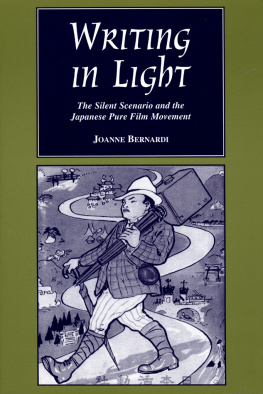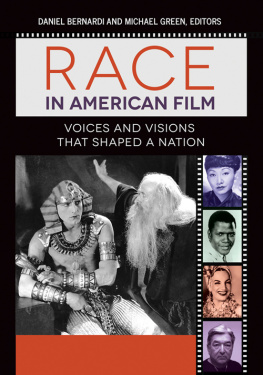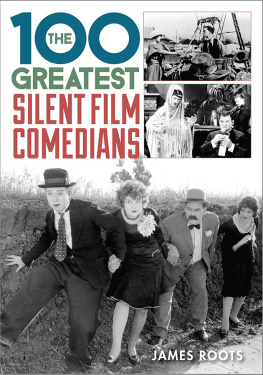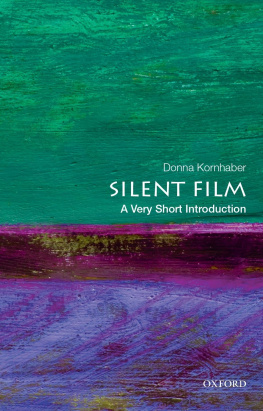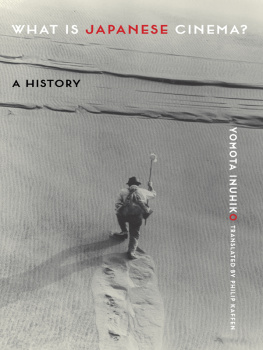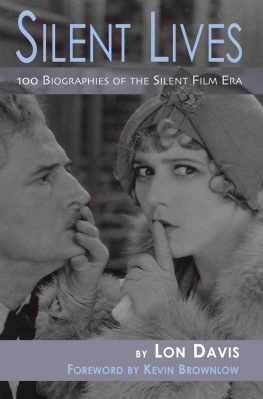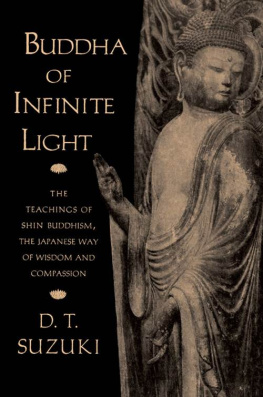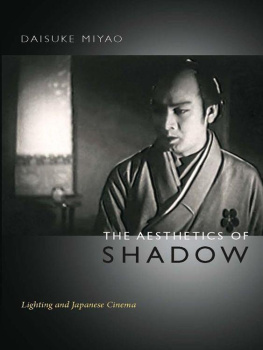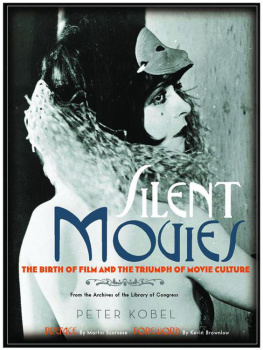Bernardi - Writing in light : the silent scenario and the Japanese pure film movement
Here you can read online Bernardi - Writing in light : the silent scenario and the Japanese pure film movement full text of the book (entire story) in english for free. Download pdf and epub, get meaning, cover and reviews about this ebook. year: 2001, publisher: Wayne State University Press, genre: Non-fiction. Description of the work, (preface) as well as reviews are available. Best literature library LitArk.com created for fans of good reading and offers a wide selection of genres:
Romance novel
Science fiction
Adventure
Detective
Science
History
Home and family
Prose
Art
Politics
Computer
Non-fiction
Religion
Business
Children
Humor
Choose a favorite category and find really read worthwhile books. Enjoy immersion in the world of imagination, feel the emotions of the characters or learn something new for yourself, make an fascinating discovery.
- Book:Writing in light : the silent scenario and the Japanese pure film movement
- Author:
- Publisher:Wayne State University Press
- Genre:
- Year:2001
- Rating:5 / 5
- Favourites:Add to favourites
- Your mark:
- 100
- 1
- 2
- 3
- 4
- 5
Writing in light : the silent scenario and the Japanese pure film movement: summary, description and annotation
We offer to read an annotation, description, summary or preface (depends on what the author of the book "Writing in light : the silent scenario and the Japanese pure film movement" wrote himself). If you haven't found the necessary information about the book — write in the comments, we will try to find it.
Bernardi: author's other books
Who wrote Writing in light : the silent scenario and the Japanese pure film movement? Find out the surname, the name of the author of the book and a list of all author's works by series.
Writing in light : the silent scenario and the Japanese pure film movement — read online for free the complete book (whole text) full work
Below is the text of the book, divided by pages. System saving the place of the last page read, allows you to conveniently read the book "Writing in light : the silent scenario and the Japanese pure film movement" online for free, without having to search again every time where you left off. Put a bookmark, and you can go to the page where you finished reading at any time.
Font size:
Interval:
Bookmark:
Contemporary Film and Television Series
A complete listing of the books in this series can be found online at wsupress.wayne.edu.
General Editor
BARRY GRANT
Brock University
Advisory Editors
PATRICIA B. ERENS
University of Hong Kong
LUCY FISCHER
University of Pittsburgh
PETER LEHMAN
University of Arizona
CAREN J. DEMING
University of Arizona
ROBERT J. BURGOYNE
Wayne State University
WRITING IN LIGHT
The Silent Scenario and the
Japanese Pure Film Movement
JOANNE BERNARDI

WAYNE STATE UNIVERSITY PRESS
DETROIT
Copyright 2001 by Wayne State University Press,
Detroit, Michigan 48201. All rights are reserved.
No part of this book may be reproduced without formal permission.
Manufactured in the United States of America.
05 04 03 02 01 5 4 3 2 1
Grateful acknowledgment is made to the Japan Foundation for its generous support of the publication of this volume.
Library of Congress Cataloging-in-Publication Data
Bernardi, Joanne.
Writing in light : the silent scenario and the Japanese pure film movement / Joanne Bernardi.
p. cm.
Includes bibliographical references and index.
Notes 000 Select Bibliography 000 Index.
ISBN 0-8143-2926-8 (alk. paper)ISBN 0-8143-2961-6 (pbk: alk. paper)
1. Motion picturesJapanHistory. 2. Silent filmsJapanHistory and criticism. I. Title.
PN1993.5.J3 B47 2001
791.430952dc21
00-011103
ISBN: 978-0-8143-4009-7 (e-book)
In memory of
YODA YOSHIKATA
CONTENTS
ACKNOWLEDGMENTS
THIS BOOK BEGAN in the spring of 1985 with a series of discussions, over a period of five years, with the late screenwriter Yoda Yoshikata. In memory of his patience (as he pointed out, some questions were better than others), and out of gratitude to his family, I dedicate it to him. Many others shared their knowledge and offered generous guidance and assistance early on. Donald Keene was a constant source of knowledge, support, and inspiration as I worked on the first version of this manuscript as my doctoral dissertation at Columbia University. I also thank the members of my committee, Paul Anderer, Richard Pea, Andrew Sarris, and David Wang.
I gratefully acknowledge the following individuals and organizations for granting permission to draw from earlier versions of portions of this book: Amsterdam University Press (The Pure Film Movement and the Contemporary Drama Genre in Japan in Film and the First World War); Columbia University Press (Tanizaki Junichirs The Present and Future of the Moving Pictures in Currents in Japanese Culture: Translations and Transformations, ed. Amy Vladeck Heinrich, 1997); the Center for Japanese Studies at the University of Michigan (The Literary Link: Tanizaki and the Pure Film Movement in A Tanizaki Feast: The International Symposium in Venice); Richard Koszarski (Norimasa Kaeriyama and The Glory of Life in Film History 9:4 [1997]); and Leonardo Quaresima (Genre Distinctions in the Japanese Contemporary Drama Film in The Birth of Film Genres).
Among friends in Japan, I am grateful to ta Yoneo, not only for his assistance in helping me with sources, but for sharing with me, over the years, his tremendous knowledge of and enthusiasm for the history of Japanese cinema. Thanks, too, to the late Miyagawa Kazuo and Takizawa Osamu, and Yamada Khei and other faculty members of the Osaka University of Arts, all of whom gave me a foundation on which to build. Makino Mamoru was, as always, generous with his time and his expertise. This book would not have been possible without his warm hospitality and kind assistance in allowing me to peruse his invaluable collection. Special thanks are due to Mr. Makino for also allowing me to reproduce illustrations from reprint editions of Katsud shashinkai, Katsud shashin zasshi, Katsud no sekai, Katsud gah, Kinema Record, and Kinema junp. Other illustrations were obtained through the kind intervention of Ted Fowler and Abe Shjir. Fujita Mitsuo kindly granted permission to reprint photographs from Tanizaki Junichir. Shinch Nihon bungaku arubamu, vol. 7 (Tokyo: Shinchsha, 1985). Hayashi Kanako, formerly of the Kawakita Memorial Film Institute, her successor, Sakano Yuka, and the Kawakita staff enthusiastically provided me with much-needed help in the form of illustrations and screenings.
My former colleagues at Ibaraki University, particularly Shimaoka Susumu and Suzuki Yoshio, were ever supportive and helped me over more than a few hurdles during the difficult early stages of research. At the National Film Center of the Museum of Modern Art in Tokyo, I thank Okajima Hisashi, Curator of Film, Saiki Tomonori, Sazaki Yoriaki, and the staff of the research study center for accommodating my tight schedule during a brief, intense flurry of research, screening, and copying during the summer of 1995. Professor Iwamoto Kenji at Waseda University kindly assisted me with library access. Mizuguchi Kaoru, formerly of the Museum of Kyoto, was very helpful in the early stages of my research, and Moriwaki Kiyotaka, Emma Michitaka, and Arita Yoshio of the Museum of Kyoto self-lessly took time from their busy schedules to provide invaluable visual and print materials and refuge from the merciless Kyoto summer. Donald Richie, who is responsible for so many peoples earliest opportunities to see Japanese films, was a continuous source of encouragement throughout my research. I would be remiss not to mention here those scholars who helped make my work easier by painstakingly collecting, preserving, and making accessible important material from the period: Iwamoto Kenji, Makino Mamoru, and their colleagues on the fukkokuban front, Komatsu Hiroshi and Ogasawara Takeo. Finally, I would have accomplished nothing in Japan without Yamazaki Hiroko, Tobita Junko, Makino Naoko, and the Nakamura and Togasaki families, who graciously shared both their friendship and their hospitality.
On this side of the world, I must first thank my colleague Sharon Willis for sharing her time and valuable insight on a draft of the manuscript and coming up with a wonderful title. Together with Sue Gustafson, she was a major source of support throughout. Colleagues Mariko Tamate and Fumino Shino helped keep me out of many a linguistic loop. The Japan-United States Friendship Committee and the Social Science Research Council, the Susan B. Anthony Institute for Gender Studies at the University of Rochester, and the NEAC (Near East Asia Council) of the Association of Asian Studies helped finance various stages of my research in Japan. I am grateful for their interest in my work. I am especially indebted to Mrs. Miyo Wagner, the late Sachiko Murakami, who guided me through my first reading of Tanizakis scripts many years ago, and the late Ichiro Shirato and his wife, Masa. David Bordwell and Tom Gunning offered insightful comments on versions of my manuscript, as did Leslie Midkiff Debauche, Frederick Dickenson, Ronald Grant, Kristine Harris, and my readers at Wayne State University Press, David Desser and Peter Grilli. At the George Eastman House, Ed Stratman and Paolo Cherchi Usai helped in many ways with both materials and screenings. At the critical stage when I had the first opportunities to present my work outside of Japan, Carol Morley at Wellesley College provided me with a home base, Kristin Thompson offered encouragement and generous comments, and Cobi Bordewijk renewed my interest in intertitles and encouraged me to attend the International Film Studies Conference on titles in silent cinema at the University of Udine. A postdoctoral fellowship at the Edwin O. Reischauer Institute for Japanese Studies, Harvard University, provided an intellectually stimulating environment and a much-needed year off from teaching duties to gather my thoughts, as well as important resources, from 1993 to 1994. Becky Copeland at Washington University in St. Louis, Kyoko Hirano at the New York Japan Society, Adriana Boscaro at the University of Venice, and Leonardo Quaresima and Francesco Pitassio at the University of Udine provided me with welcome opportunities and venues for feedback on my research in progress.
Next pageFont size:
Interval:
Bookmark:
Similar books «Writing in light : the silent scenario and the Japanese pure film movement»
Look at similar books to Writing in light : the silent scenario and the Japanese pure film movement. We have selected literature similar in name and meaning in the hope of providing readers with more options to find new, interesting, not yet read works.
Discussion, reviews of the book Writing in light : the silent scenario and the Japanese pure film movement and just readers' own opinions. Leave your comments, write what you think about the work, its meaning or the main characters. Specify what exactly you liked and what you didn't like, and why you think so.

